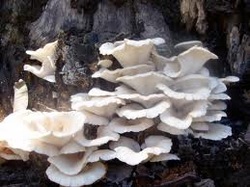- Home
- Mushrooms - why?
- Chaga mushroom - medicinal
- Red reishi - medicinal
- Chicken mushroom – food
- Puffballs - food
- Maitake mushroom - medicinal
- Chanterelle mushroom - food
- Lobster mushrooms - food
- Honey mushrooms -food
- Shiitake mushroom – medicinal and food
- Morels - food
- Oyster Mushrooms - medicinal and food
- Common poisonous mushrooms in NC
- How to grow oyster mushrooms at home
- Blog
Oyster mushroom

These are three-season mushrooms, growing in clusters on trees and fallen logs from spring through autumn. They even grow during the winter
months in places with warm winters and may sprout elsewhere during a period of abnormally warm winter weather.
These mushrooms are two to eight inches wide, white or off-white with an ovoid, oyster shell-shaped cap. White gills run down its very short stem.
This mushroom is one that novice hunters should seek because the consequences of making a mistake are not lethal, according to the Missouri Department of Conservation. While there are plenty of undesirable
mushrooms that look like oyster mushrooms, the look-alikes merely taste terrible and are not truly poisonous.
Often "oyster" is a term that defined a single mushroom on the market. However, many species are available today which have significant differences in texture and flavor. The Oyster mushroom is also called abalone and shellfish mushroom, though it should not be confused with other given names. It is botanically classified as Pleurotus ostreatus. It is a common edible mushroom.
Oyster mushrooms have scallop-shaped caps that range in sizes from button to sand dollar. Their coloring varies from snow grey to pale brown. Oyster mushrooms are rather mild and sweet in flavor. They have a soft fragile texture with good melting qualities and a light fruity fragrance.
The Oyster mushroom is one of the few members of their genera that contains vitamin C. It also contains eight amino acids, B vitamins, a high amount of protein and equally high amounts of essential fattyacids.
Oyster mushrooms pair well with seafood and white meats. The Oyster mushroom's meaty texture lends well to frying, stir-fry’s, and braising. Complementary flavors include Asian greens, soy, garlic, vinegar, and rice wine. As they are extremely perishable, use Oyster mushrooms as soon as possible for
optimum flavor and quality. Do not wash mushrooms until just before use.
months in places with warm winters and may sprout elsewhere during a period of abnormally warm winter weather.
These mushrooms are two to eight inches wide, white or off-white with an ovoid, oyster shell-shaped cap. White gills run down its very short stem.
This mushroom is one that novice hunters should seek because the consequences of making a mistake are not lethal, according to the Missouri Department of Conservation. While there are plenty of undesirable
mushrooms that look like oyster mushrooms, the look-alikes merely taste terrible and are not truly poisonous.
Often "oyster" is a term that defined a single mushroom on the market. However, many species are available today which have significant differences in texture and flavor. The Oyster mushroom is also called abalone and shellfish mushroom, though it should not be confused with other given names. It is botanically classified as Pleurotus ostreatus. It is a common edible mushroom.
Oyster mushrooms have scallop-shaped caps that range in sizes from button to sand dollar. Their coloring varies from snow grey to pale brown. Oyster mushrooms are rather mild and sweet in flavor. They have a soft fragile texture with good melting qualities and a light fruity fragrance.
The Oyster mushroom is one of the few members of their genera that contains vitamin C. It also contains eight amino acids, B vitamins, a high amount of protein and equally high amounts of essential fattyacids.
Oyster mushrooms pair well with seafood and white meats. The Oyster mushroom's meaty texture lends well to frying, stir-fry’s, and braising. Complementary flavors include Asian greens, soy, garlic, vinegar, and rice wine. As they are extremely perishable, use Oyster mushrooms as soon as possible for
optimum flavor and quality. Do not wash mushrooms until just before use.
